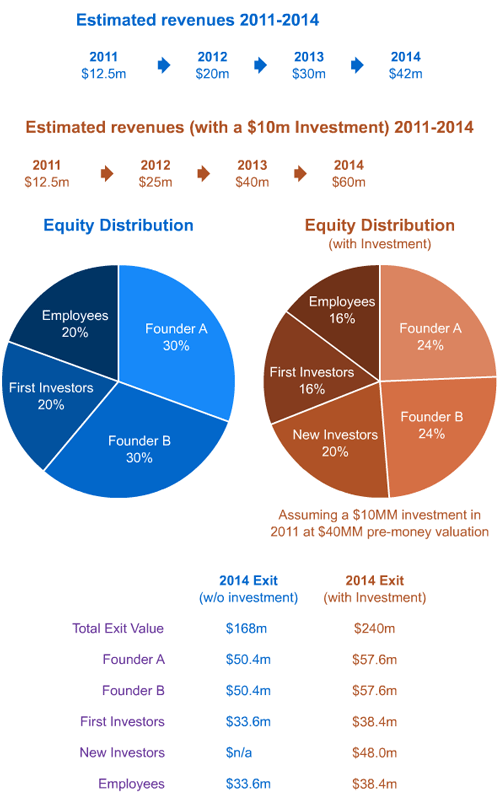We’ve gotten a lot of interest from venture capital, private equity and other types of investment firms lately at Moz. Nearly every week features a phone call or two to answer some of that inbound interest. I suspect it’s due to multiple factors, but the current, hot investment environment and upward slope of the search marketing sector combined with some growth on our end probably creates a lot that demand.

And yet, despite my prior advice to myself that this situation is a potentially ideal one in which to take venture capital, I’m leaning against taking another round.
Typically, when a company takes outside investment, the goal is to scale up the organization so it can become more valuable more quickly than it could have without the money. Indeed, profitable companies only have an incentive to take outside funds if they’re fairly certain that the dilution they take will be made up by a greater overall value/return.
Here’s a fairly simple example of a mid-stage, profitable company taking a round of investment and what that means for various parties:

Overall, it looks reasonably good. Everyone wins a little bit bigger, right?
Here’s why many savvy folks wouldn’t engage in this deal:
• The risk goes up for everyone (except the new investors). Trying to leverage millions of dollars in new funding to grow faster is, often, much more dangerous than growing at a more measured pace.
• The potential gains are, relatively speaking, small. Founders + employees only come out a little more than 10% ahead of where they did in the non-funding scenario, but are adopting more risk and, often, more challenges than in the slower growth scenario.
• New investors usually mean new board members, which add complexity and uncertainty at the top. They also add votes to the board of directors. That could mean a switch in who controls the board (founders vs. VCs) in (rare but dangerous) antagnostic scenarios.
• More limited options are now available as an exit. In our prior scenario (in blue above), the company could choose to sell for any reasonable offer over the years. In the investment scenario (in orange) there’s often a liquidation preference, signing clause or other power that preferred (investor) stock holds over common (founder+employee) stock to block a sale. Granted, most of the time, investors don’t use this to block founders from an exit (it’s in no one’s best interests), but no reasonable entrepreneur should discount the potential.
• It can be a challenge to know where + how to spend the cash wisely, and that process can distract from work that might have moved the business ahead at a similar (or even faster) pace.
That last bullet point is the one I want to concentrate on, because more than any other on the list, it’s the reason I’m personally hesitant to raise more capital and, ironically, the least discussed reason that I’ve seen covered in other content on this topic.
At Moz, out primary inputs into growth are marketing + product/engineering. We can either get more people aware of our software and heading to our site to check it out and/or we can improve + grow the product itself.
The illustration below may not be worth 1,000 words, but it will save you lots of boring paragraphs on what impacts what.

Those primary inputs – marketing + product – encompass nearly everything the business can do to scale. And they have different limiting factors.
Marketing scales with great ideas and great execution of those ideas. It relies on great operators (those who combine experience, judgement and creativity with getting shit done) writing, designing, publishing, pushing (through search, social + other channels) and measuring effectively. It’s a challenging process, but at Moz at least, it’s not a major limiting factor.
We currently draw 1.2+ million visits to our sites and are growing at a substantial pace (traffic’s up more than 10% month-over-month). The problem is more the propensity of those visitors to need our software – plenty do and sign up (~100/day), and plenty more need it but don’t know they need it (which is an area where marketing can help). More dollars from investment could help us pay more to acquire customers, but our COCA (cost of customer acquisition) is very low and our payback period is very fast, so any high ROI areas of investment we can find are already being saturated (or will be once we get the time).
Adding money can help marketing a little, but probably not in proportion to the dilution or other potential issues we’d face from outside investment (detailed above). We’d likely invest in riskier, lower ROI marketing activities and while we’d grow somewhat faster, the cost to grow would rapidly increase.
By far the largest opportunity, then, is in simultaneously simplifying the product while adding features that make it more appealing and more essential to a wider range of web marketers. This will both increase the addressable market (to which we can then spend time/energy marketing to), convince more of the market we already capture to buy and, perhaps most importantly in a SaaS business, improve retention.
That leads us to product/engineering which scales with people, but not in an intuitive or easily-calculated way.

We already work hard to grow the engineering team (e.g. our $12,000 refer an engineer program), but we do at a sustainable pace, adding no more than 1-2 engineers a quarter. This may seem quite slow, but it reduces the impact on the existing team and means we can be extremely picky about those engineers we do select.
Granted, bringing on engineers too fast could hurt short-term progress but mean bigger gains in the future (when all those folks are “ramped up”). Bringing in low-quality engineers, however, is the far greater risk. People who either don’t fit the team culture or produce less-than-exceptional code pose a massive, systemic risk, and one we’ve faced and had to overcome in the past.
While investment might help us offer higher salaries or even larger recruiting+signing bonuses, it’s hard to imagine how they’d truly assist in scaling the organization without heaps of risk, uncertainty and potentially going slower based on these factors, rather than faster!
I don’t pretend to know everything on this topic. I’m a first time CEO and startup founder and have plenty of wrong decisions in my past. But, I do hope that by examining the situation carefully and prioritizing the right factors, I can come to a decision that’s logical and worthy of the responsibility I’ve inherited.
Today, that decision is to self-sustain without shutting the doors on the possibility of raising capital in the near or far future. And, of course, since I’m blogging this, I’d love any opinions, experiences or recommendations you’ve got, too. If I felt confident today that we could use money to grow the business much more dramatically than we could without funding (and without adding massive risk), I’d take that leap. But, in the meantime, I can’t honestly ask my team or my co-founder to take on dilution and risk when the company is profitable and growing.